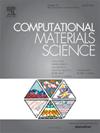2D-diffractogram analysis: Kinematic-diffraction simulator for neural-network training-data generation
IF 3.1
3区 材料科学
Q2 MATERIALS SCIENCE, MULTIDISCIPLINARY
引用次数: 0
Abstract
To exploit the information contained in 2D X-ray diffractograms fully, quantitatively, automatically, and with high throughput, e.g. for analyzing video sequences from in-situ experiments, we can train deep-learning NNs (neural networks) with simulated diffractograms. Realistic models of materials microstructures require “ground truth” training datasets of high cardinality. To produce these, we developed a “kinematic-diffraction simulator,” implemented in the Wolfram Language and executed within a high-performance computing environment. The simulator can rapidly generate Fraunhofer diffractograms for diverse crystal- and microstructure models over a significant multi-dimensional space of parameters. We conclude that simulated diffractograms can enable suitable training of deep-learning NNs – in spite of not including some “real-world” features that occur in experimental diffractograms – and that high-performance computing achieves training data generation rates that support modeling of microstructures with a realistically large number of parameters.

求助全文
约1分钟内获得全文
求助全文
来源期刊

Computational Materials Science
工程技术-材料科学:综合
CiteScore
6.50
自引率
6.10%
发文量
665
审稿时长
26 days
期刊介绍:
The goal of Computational Materials Science is to report on results that provide new or unique insights into, or significantly expand our understanding of, the properties of materials or phenomena associated with their design, synthesis, processing, characterization, and utilization. To be relevant to the journal, the results should be applied or applicable to specific material systems that are discussed within the submission.
 求助内容:
求助内容: 应助结果提醒方式:
应助结果提醒方式:


